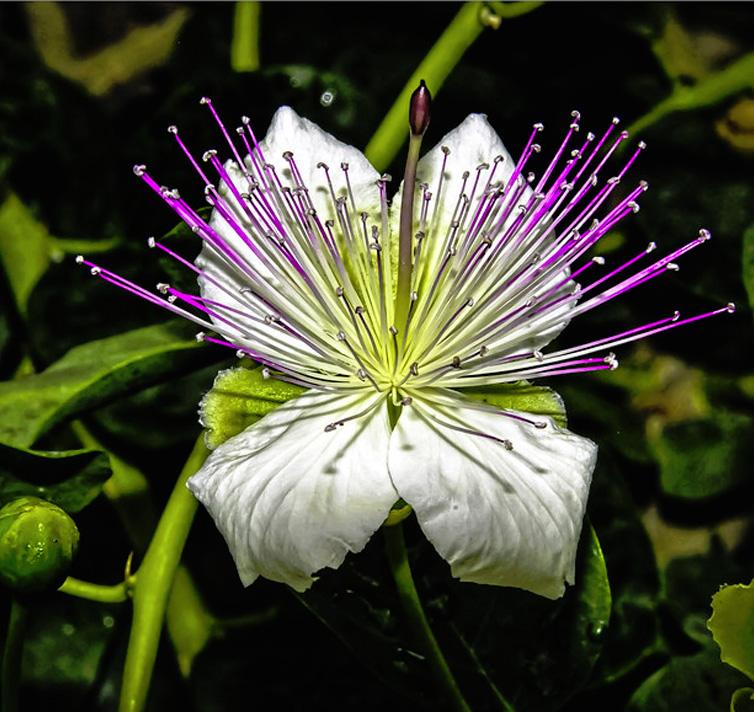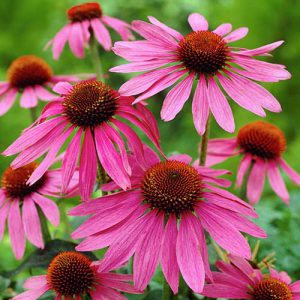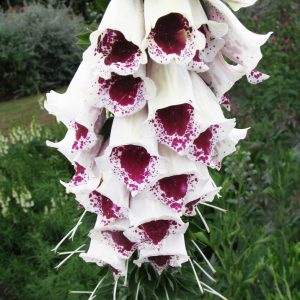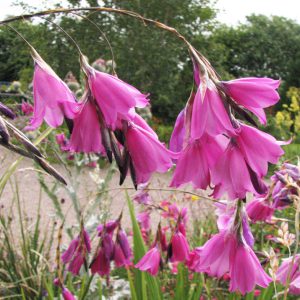- 1-9 pkts $4.50
- 10 pkts FREE
- Express post $12
Capparis spinosa
CAPER BUSH
Capparis spinosa bush is the source of edible capers. So you can harvest your own delicious capers at home to use in cooking.
Simply harvest flower buds before they open to make capers.
Or harvest the fruits after flowering to make Caperberries.
The source of delicious culinary capers
This is the true spineless caper, superior for culinary use.
Many inexpensive caper products are not true capers, but actually Nasturtiums. While Nasturtiums are cheaper the flavour is inferior.
Pretty blooms if you don’t eat them all
The flowers of the Caper Bush are very showy. So make sure you don’t harvest them all.
Flowers are large, white, and each with a spectacular brush of purple stamens like a firework explosion.
And they have a sweet scent.
Though the whole bush of Capparis spinosa is attractive, as well as useful.
With red stems, glossy semi-succulent leaves, a profusion of showy flowers, and graceful arching growth.
It is evergreen and an asset to the garden all year round.
Caper Bush loves sunbaking & a lean diet
Capparis spinosa is native to places with hot summers, such as Morocco and Croatia.
So it loves sun and good drainage.
And will happily grow out of old walls, including making it’s home amongst the stones of ancient Roman ruins.
Caper Bush is drought hardy once established, and loves to sunbake in poorer, dry, rocky or sandy soil.
So it is a very water-wise choice for gardeners with limited water.
Rabbits & deer do not share our love of capers
Fortunately rabbits and deer do not share our love of capers and leave Caper Bush alone.
Low maintenance
Capparis spinosa can happily thrive with little or no help from us. Though if you want a big harvest of capers then an annual hard prune is recommended. As flowers are more abundant on new wood.
Evergreen shrub
75cm High x 1.4m Wide approx.
SEED SOWING ADVICE:
While it is not essential to give Capparis seeds a chilling, it does seem to improve their germination rate.
So first sow the seed in a punnet on the surface of good quality seed raising mix.
Then gently press the seeds onto the surface of the mix, to ensure good contact.
Now barely cover seed with sieved mix, or fine grit, or vermiculite, or washed sand.
Then place the sown punnet into a water bath (make sure the water level in the bath is below the surface of the mix).
So the moisture percolates up through the mix from the bottom to thoroughly moisten the mix throughout.
Soak for a short time until moisture appears on the surface of the mix, and then remove and drain.
Because the mix needs to be moist throughout, but not wet.
Give the seed a pretend winter
Now wrap the punnet in cling-wrap and place in the fridge (not freezer) for 6-8 weeks.
The remove from fridge, unwrap, moisten, place the moist punnet in a warm, well-lit position (not in direct sun).
Temperatures of 18-22°C approx. are best for rapid and optimum germination.
You can use a temperature-controlled heat mat if you have one to encourage rapid germination, but it is not essential. A window-sill or well-lit corner is also fine.
Adding a clear plastic cover helps to retain moisture in the punnet.
And continue to keep the punnet moist by spraying the surface of the mix a fine spray water bottle, or re-soaking in the water bath, as required.
(If the punnet is light weight when you pick it up – the mix is drying out and needs another soak from below in the water bath).
Seedlings emerge in approx. 14-28 days.
SEED COUNT: 10 seeds per pack approx.
(We always aim to exceed the stated seed count, and give a generous serve).
Click here for our Nursery Open Days & Open Gardens Information
https://www.gardivalia.com.au/open-gardens
Click here to go back to Seeds Shop
https://www.seedscape.net.au/shop/
Related products
-
Add to WishlistAlready In WishlistAdd to Wishlist
-
Add to WishlistAlready In WishlistAdd to Wishlist
-
Add to WishlistAlready In WishlistAdd to Wishlist
-
All
Dierama pulcherrimum
‘Rose Pink’
ROSE PINK
FAIRY FISHING RODS
SALE: Buy 1 get 2 packs
$5.00 AUD Add to cartAdd to WishlistAlready In WishlistAdd to Wishlist





